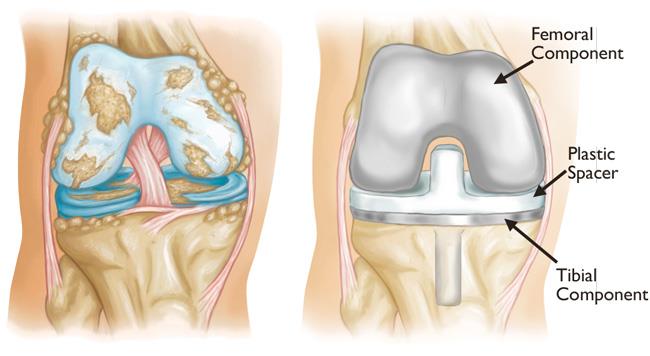
In severely diseased knee joints, knee replacement surgery, or knee arthroplasty (ARTH-row-plas-tee), can relieve pain and restore function. During the procedure, your thighbone, shinbone, and kneecap are cut away and replaced with metal alloys, high-grade plastics, and polymer artificial joints (prostheses).
Your orthopedic surgeon assesses your knee's range of motion, stability, and strength to determine whether you need a knee replacement. The extent of the damage can be determined by X-rays.
Depending on your age, weight, activity level, knee size, shape, and overall health, your doctor can recommend various knee replacement prostheses and surgical techniques.
The most common cause of chronic knee pain and disability is arthritis. Although there are many types of arthritis, most knee pain is caused by just three types: osteoarthritis, rheumatoid arthritis, and post-traumatic arthritis.
1. Osteoarthritis. This is an age-related "wear and tear" type of arthritis. It usually occurs in people 50 years of age and older, but may occur in younger people, too. The cartilage that cushions the bones of the knee softens and wears away. The bones then rub against one another, causing knee pain and stiffness.
2. Rheumatoid arthritis. This is a disease in which the synovial membrane that surrounds the joint becomes inflamed and thickened. This chronic inflammation can damage the cartilage and eventually cause cartilage loss, pain, and stiffness. Rheumatoid arthritis is the most common form of a group of disorders termed "inflammatory arthritis."
3. Post-traumatic arthritis. This can follow a serious knee injury. Fractures of the bones surrounding the knee or tears of the knee ligaments may damage the articular cartilage over time, causing knee pain and limiting knee function.
A knee replacement (also called knee arthroplasty) might be more accurately termed a knee "resurfacing" because only the surface of the bones are replaced.
There are four basic steps to a knee replacement procedure:
1. Prepare the bone. The damaged cartilage surfaces at the ends of the femur and tibia are removed along with a small amount of underlying bone.
2. Position the metal implants. The removed cartilage and bone is replaced with metal components that recreate the surface of the joint. These metal parts may be cemented or "press-fit" into the bone.
3. Resurface the patella. The under surface of the patella (kneecap) is cut and resurfaced with a plastic button. Some surgeons do not resurface the patella, depending upon the case.
4. Insert a spacer. A medical-grade plastic spacer is inserted between the metal components to create a smooth gliding surface.

There are several reasons why your doctor may recommend knee replacement surgery. People who benefit from total knee replacement often have:
1. Severe knee pain or stiffness that limits everyday activities, including walking, climbing stairs, and getting in and out of chairs. It may be hard to walk more than a few blocks without significant pain and it may be necessary to use a cane or walker
2. Moderate or severe knee pain while resting, either day or night
3. Chronic knee inflammation and swelling that does not improve with rest or medications
4. Knee deformity — a bowing in or out of the knee
5. Failure to substantially improve with other treatments such as anti-inflammatory medications, cortisone injections, lubricating injections, physical therapy, or other surgeries